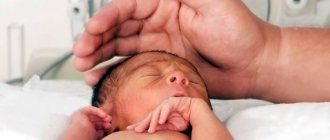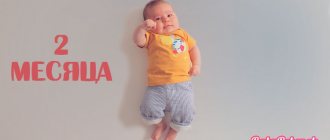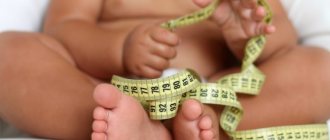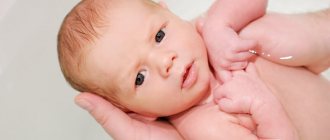For parents, the health of a child is an important condition for its normal and full development.
They try to carefully monitor his progress, which he makes from the first days of his life, and are sincerely happy when he succeeds.
It is especially important to monitor the development of the baby in the first year of his life; at this stage it is worth taking into account every detail so as not to miss important details.
The development of the newborn is monitored weekly and monthly. For this purpose, special diagrams, tables, and calendars have been developed, which reflect all the important nuances and criteria.
With their help, the physical and mental state of the child is assessed.
Development of newborns by week
During the first weeks of life, the little person’s body does a tremendous amount of work. He must adapt to the new reality, launch the work of the most important systems, acquire many skills in order to further transform them into skills. Knowledge of the main stages of development of a newborn, its physiology and mental characteristics will help young mothers competently care for their newly born babies and respond in a timely manner to possible deviations and pathologies.
Causes for concern
Many children often spit up after feeding at first. Normally, this can happen because the digestive tract is still poorly formed, the nervous system is underdeveloped, and the feeding process is not happening entirely correctly. Regurgitation is common in the first weeks of life. If a baby swallows air along with food while feeding, he may burp. Nothing wrong with that. Try to change your position so that less air gets into the baby's mouth.
The second reason for parents’ anxiety is a slight loss in the weight of the newborn (we recommend reading: a table with the norms for the weight of a newborn child). There's nothing to worry about. When the mother begins to produce milk abundantly and the feeding process improves, the baby will begin to gain weight again.
Often, on the 2-3rd day of life, the baby turns a little yellow - this is a physiologically justified phenomenon. A large amount of bilirubin is formed in the blood, which contributes to yellowing of the skin. By 7-14 days, skin color should return to normal.
Sometimes the baby's skin peels off in the first days. When it is born, the body is coated with natural lubricant to facilitate passage through the birth canal. Then, when exposed to air, the lubricant dries and begins to peel off. This is a natural process and there is nothing to worry about.
The child will very soon make up for the slight weight loss that occurs in the first days of life
Physiology of newborns
The anatomical and physiological structure of a newborn has a number of features that a young mother needs to know about in order to properly organize the care of her baby. A newly born person has an unusual physique. His head is disproportionately large compared to his body and his limbs are too short. It is ¼ of the body length (for comparison, in an adult it is 1/7 or 1/8). The parietal and frontal bones have not yet fused; the soft place between them is called the fontanel. Until dense bone tissue appears in its place, you need to be very careful not to injure the baby. Every newborn has an umbilical wound, or the so-called umbilical cord. It is better to entrust her care to a medical professional. Improper handling of the umbilical cord can lead to blood poisoning.
Another feature is the baby’s very delicate, vulnerable skin. In the first days of a baby's life, the skin changes color from deep pink to yellow (so-called physiological jaundice). There is no need to be scared, this is normal. Already on the fourth or fifth day, the skin will take on a pleasant pale pink tint.
You should also pay attention to the appearance of dry skin scales on the body and especially on the head. This is the result of the intense work of the sebaceous glands, of which there are a lot on the body of a newborn. The resulting scales must be carefully cleaned off. Ignoring this hygiene procedure can lead to the appearance of pathogenic bacteria, microbes and inflammation.
The baby's muscles are poorly developed. He cannot control them yet; the experience of controlling his body comes gradually. Other organ systems (digestive, circulatory, respiratory, nervous) are also at the initial stage of development.
The baby's heat exchange is also in its infancy. Newborn babies become hypothermic and overheated very quickly. Those who fanatically try to protect the child from the cold are mistaken. Overheating is as dangerous as cooling.
As for height and weight, the normal weight is between 2,800 and 4,500 g, height varies from 45 to 55 cm. Premature babies weigh from 1,000 to 2,500 g.
During the first year of life, height and weight indicators are systematically recorded. Using them, the doctor can determine how the process of anatomical and physiological development of the baby is proceeding, and prevent possible diseases and pathologies.
How a child is formed before birth
Oxalates in the urine of a child under one year of age—causes of occurrence, calcium levels
It all starts with two cells - the gametes of the mother and father. They merge, and one cell is obtained. She will grow into a whole person, but for now she stores all the information about what he will be like. Many mothers are interested in how the baby grows in their belly. It goes like this:
- The origin of life begins with fragmentation - by the 5th day several dozen appear from one cell. In addition, a hollow ball is formed from them - a blastocyst.
- About a week after conception (on average, three weeks after the last menstruation), the embryo migrates from the fallopian tubes, where fertilization occurred, to the uterus. There it is introduced into the mucous membrane - attachment.
Note! It is impossible to know about pregnancy until the fetus attaches to the wall of the uterus. Neither blood for hCG nor tests will give results. In the second or third weeks, this is also difficult to do, but possible. That is why it is usually diagnosed at 3-4 weeks, that is, by the end of the first month. An ultrasound will give results no earlier than 5 weeks, or even later - the embryo simply will not be seen before.
Stages of embryo development
- By 4 weeks from conception (many already know about their position by this time), the fetus has a beating heart (an ultrasound will show it later), blood circulation, and all the most important internal organs, including the brain, begin to develop. By this time, the unborn baby has already formed an umbilical cord, there are rudiments of limbs, eye sockets, development continues.
- Moms wonder what the baby looks like in their belly. By the end of the first trimester, he finally looks human. He already has all the internal organs, the rudiments of limbs and distinguishable facial features. It is protected by the placenta.
- In the second trimester, the development of what was laid down in the first continues. By the middle of pregnancy (20 weeks), most women find out about the sex of the child through screening (checking developmental norms using ultrasound). Hair begins to grow on the baby's head, and nails begin to grow on the hands. He is actively moving, the expectant mother can already feel it.
- The closer the time of birth, the more the child resembles his parents, the less space remains for him to move.
Fetal development norms by week
Doctors monitor the development of the child's fetus. One of the most informative studies is ultrasound. With its help, fetometry is carried out - measurements of parts of the fetus, which are carried out at 1, 2, 3 screenings. This allows the baby's development to be tracked week by week. If, for example, the head volume indicator lags behind, this is a symptom of intrauterine growth retardation.
A lot of things are measured during this study, the key indicators are approximate weight, height, chest volume, head volume, hip bone length. The average norms for these indicators of baby development by week can be found in the table below.
Basic norms of fetometry: BPR - biparental size, DB - thigh length, DHA - chest length
Important! The ultrasound doctor gives a description of the result obtained. This skill requires serious preparation, so you should not evaluate the data yourself - there is a high probability of error.
Fetal weight
By 40 weeks, the threshold for a baby’s normal weight is 2.5 kilograms. A low birth weight or premature baby is taken under special medical supervision.
Previously, low weight was considered a phenomenon incompatible with life - the lighter the child, the more difficult it is for him to survive. He may not latch onto the breast, he is very weak. Today, with the development of medicine, babies with a birth weight of even just 500 grams are being cared for.
Height
The average growth rate at 40 weeks is 50 centimeters. This figure may be less or more. A lot depends on genetics here. If a child is born 45 centimeters long, but is completely healthy and developed, this is considered normal.
Child's reflexes
A reflex is a reaction to an external stimulus. At the first stages of life, the baby has the following reflexes:
- protective (while lying on his stomach, the child turns his head, trying to follow a possible stimulus);
- sucking (the baby makes sucking movements if you put a pacifier in his mouth);
- grasping (the child grasps and firmly holds any object placed in his palm);
- support reflex (feeling support under the legs, the baby rests on it with his entire foot);
- automatic walking reflex (manifests itself as a continuation of the support reflex - the baby walks on the surface);
- crawling/Bauer reflex (when lying on the stomach the child makes crawling movements);
- holding your breath (the baby holds his breath for a few seconds when water hits his face).
The presence of these and some other innate reflexes indicates the correct mental development of the baby. They will certainly be checked by a pediatrician during a routine examination of the child. Over time, most simple reflexes fade, giving way to more complex behavioral patterns.
Newborn baby reflex table
Newborn baby reflexes chart
The fourth week of the period and its features
During the fourth week, the baby’s weight increases by another 200 g, 3-4 cm is added to height, and 1-2 cm to circumference. The development of motor skills is noticeable; some babies are able to hold their head when turning onto their stomach. The child develops an interest in bright and noisy toys and people around him.
At this time, it is recommended to communicate with the baby as much as possible, talk to him, and turn on calm music. By the end of the month the baby's o. He rejoices at familiar faces, showing his positive emotions by twitching his legs and arms.
Mental development of a newborn
The baby is born with an arsenal of innate reflexes that help him survive in the first weeks of life.
During the first year, the child takes a giant step in mental development. He learns to focus on specific objects and actions, masters the art of responding (turns his head to the voice of someone close), acquires the first social skills (for example, smiling), and imitates the behavior of others. The emotional sphere of the newborn is still little studied. Scientists talk about three main states of a baby in the early stages of life: excitement, dissatisfaction (manifested through crying) and pleasure. Observation of a child in various states allows us to conclude that even the smallest person has his own individual characteristics. These are the first rudiments of the character and temperament of the emerging personality.
So, some children are calm, fall asleep easily and cry only in the presence of a real stimulus (cold, hunger, pain, etc.). Others are very active, violently express their displeasure for any reason, and require constant attention from others. Still others, on the contrary, only need their mother’s company; strangers make them panic. This list can be continued with various variations ad infinitum. Psychologists tried to systematize the range of children's emotions and identified three types of newborn temperaments:
- easy;
- average;
- heavy.
Is your baby spitting up like a fountain? If yes, then we wrote this article especially for you! Are you positioning your baby correctly for feeding? Do you know what the consequences can be if you do it wrong? Read our article on this topic, it was written to help you.
Do you know how to choose the right hat size for a newborn? You can get a comprehensive answer from this link.
How should parents behave during this period?
Specific recommendations from child psychologists and pediatricians on how parents should behave during growth spurts look like this:
- Calmly accept current events. After mom and dad are convinced that their baby is going through a crisis and does not need to be examined by a doctor, they should stop worrying and look for deviations in the development of their own child until the situation is completely stabilized.
- Do not change already established habits in the child’s life. For example, do not give up breastfeeding, do not exclude planned naps.
- Eliminate excessive strictness and exactingness towards the baby. Do not force him to fall asleep at a specific time, loyally shifting it to a more comfortable time for the child; feed on demand, avoiding acute hunger in a growing person.
- Do not indulge your child's whims thoughtlessly. If a mother, avoiding her son or daughter’s crying, unquestioningly fulfills all the children’s “demands,” the leap in development will certainly develop into a change in the child’s behavior pattern. He will become less obedient, will begin to fall into hysterics more often when he encounters resistance from adults, and will begin to manipulate. To avoid this, parents should not prevent the baby’s emotional outbursts, depriving him of the opportunity to get rid of psychological stress, but help him cope with stress, distract him, talk as much as possible, trying to end the crying with words as soon as possible.
It is important for parents to understand that they will not be able to avoid problems associated with their child’s developmental leaps. Changes in psychological and physical terms are natural stages of personality development, accompanied by increased emotionality and stress on the part of the fragile child’s psyche
Development of vision in newborns
The most important indicator that the nervous system is progressing successfully is the development of vision in the newborn. Physically, the baby’s eyes are ready to look at the world like adults, but the brain cannot yet comprehend everything he sees.
The newborn clearly sees and focuses only on objects that are at a distance of no more than 30 cm. He sees his mother’s face, his rattle, in the background there is only light and unclear outlines for him. At first, the baby will be occupied only by static objects, but in the fourth week he will learn to follow moving objects. Staring games or spinning toys will give your little one great pleasure.
In the second month, the baby becomes familiar with color. So far, he is attracted to contrasting patterns, especially black and white pictures.
A 4-month-old baby no longer perceives the world as a flat picture, he begins to feel and see space. Hence new useful skills - now the baby can take an object.
At the 5th month of life, the child begins to distinguish halftones. And by the 8th month, the baby’s vision is completely formed.
Each stage of development of a newborn's vision should be monitored by a doctor. Any pathologies (strabismus, farsightedness, myopia, problems with blood vessels, etc.) are best diagnosed at the earliest stages.
Eleventh month
- At eleven months, your baby is strong enough to begin taking his first steps without support. The child can walk a short distance from one adult to another, or from a support to his mother. The baby actively moves in any room: crawls, sits, stands, walks with support.
- Self-care skills continue to develop. The man tries to eat with a spoon, drink from a cup, and tries to put on or take off his clothes himself. You can keep your little one occupied for a long time if you offer him a box of clothes. The child’s independence must be encouraged, especially since children at this age love to be praised.
- The eleventh month of child development is the time when the first meaningful dialogues appear. The baby perfectly understands the meaning of the words “yes”, “no”, “impossible” (find out from the article how to explain to your child what is prohibited>>>); knows how to nod positively and shake his head negatively.
- In addition, the baby looks and points with his finger at an object of interest. In this way, the baby communicates with adults, parents and the child begin to understand each other better. The number of spoken syllables is growing. At this time, two or three clearly pronounced words may appear in the baby’s speech (most often these are “mom”, “dad”, “baba” and some kind of onomatopoeia, for example, “av”).
- Eleven-month-old babies begin to master polite communication skills: they easily remember the “hello” and “bye” gestures, and willingly wave their hands.
On a note! Although this is still a game for them, parents are encouraged to always ask their child to say hello and goodbye to reinforce this positive habit.
At 11 months, babies are very excitable and easily move from laughing to crying. They become wary in an unfamiliar place and become frightened when a new person appears. These manifestations indicate the normal development of the child’s psyche and should not upset parents.
Read more: What should a child be able to do at 11 months>>>
Hearing development in newborns
Unlike vision, a baby’s hearing is fully developed from the first days of life. He is the child’s main guide in the new world and contributes to the development of other important skills. As the baby grows up, he will learn to identify the source of the sound and consciously respond to his own name and the speech of others.
To develop hearing and understanding, you need to constantly talk with your child. Sing him songs, read books, play recordings of fairy tales and musical compositions. All these activities are integral stages on the path to the most important skill that a little person will have to master - speech.
Features of the first week of a baby's life
The first week of a newborn’s life may be accompanied by the following:
- Pronounced birth edema is sometimes observed on the head. This is a soft tumor with a dough-like consistency and often acquires a bluish tint. You cannot massage it, and applying various ointments and compresses is also prohibited. After a few days of waiting, it will go away on its own.
- In babies born naturally, the head may take on a slightly elongated shape. Her condition returns to normal approximately 10-12 days after birth.
- On the first day, children sometimes develop physiological erythema. Uniform redness of the skin in response to the adaptation of blood vessels to environmental conditions usually disappears within 12-48 hours.
- On days 3-5 of a baby's life, toxic erythema may occur. It is characterized by the appearance of dense red spots that are sometimes itchy. The phenomenon is considered a peculiar manifestation of an allergy, which develops and increases over a couple of days, after which it goes away on its own. In rare cases, drug therapy is required.
- 2-3 days may be marked by the appearance of signs of physiological jaundice. In the normal course of events, it goes away on its own by the second week.
- The baby's first stool is a viscous dark green mass. After the first bowel movement, bowel movements occur up to 6-8 times a day.
- Children in the first two days of life relieve minor needs only 2-6 times a day. On the 5th-6th day, a brown spot may appear on the baby’s diaper, on which, after drying, a fine powder becomes visible - uric acid crystals. There is no need to be afraid of this, everything will return to normal quite quickly.
In addition, in the first week of life the baby sleeps a lot, wakes up only to feed, and loses up to 10% of its original body weight.
Stages of Newborn Development
The development of a newborn occurs in several stages. The first stage (the first 5 weeks) is the baby’s adaptation to the new world, its inhabitants and his own body. A little person experiences the greatest stress in the first week of life. Try to create the most comfortable conditions for the baby, isolate him from all possible irritants.
At the second stage (5th–8th weeks), with the development of the senses, the baby begins to actively explore the world around him. Now he stays awake a lot and causes more trouble because he reacts emotionally to every new phenomenon of reality.
By the end of the 12th week, the child already sees and hears perfectly and is ready for intellectual development.
You can learn how to treat a newborn’s navel from our article. When a child begins to hold his head read here.
Soft flooring for children's rooms, all information on the link
Twelfth month
The twelfth month of child development is a kind of transition period from infancy to childhood. Although this limit is very arbitrary, psychologically parents expect much more from a one-year-old child than from an eleven-month-old.
At one year of age, the baby most often begins to walk.
Don't worry if your child doesn't do this yet; Children have the right to crawl until they are one and a half years old, and this is not considered a pathology.
Read the article on what to do if a child is afraid to walk independently>>>
- A little man at this age already knows how to squat to pick up a toy; can put down one item and pick up another. Children know very well where everything is and will look for the toy exactly where they left it;
- Kids learn to step over obstacles: first, holding an adult’s hand, and then on their own;
- Everyday skills develop: the child eats with a spoon, drinks from a cup, puts on and takes off hats and socks;
- If the baby has been potty trained, at one year old such children may already ask to use it. Information about at what age to potty train a child>>> At one year, the child eats food in pieces and knows how to chew. If the chewing teeth have not yet grown, children chew with their gums (they are quite hard);
- A one-year-old child understands everything that is said to him, even if his parents think that this is not so. He perfectly knows how to read the mood and succumbs to it: he is happy and sad with his mother. Psychologists do not recommend sorting things out and quarreling in front of a child. Since the baby does not yet know how to cope with his emotions, this can cause him serious injury.
The baby not only understands everything that is said to him, but also babbles a lot and pronounces individual words.
Important! At this age, teachers consider all stable sound combinations that always mean the same thing to be words. Vocabulary by one year old – from two to ten words; in some children it may be even greater
Vocabulary by one year old – from two to ten words; in some children it may be even greater.
At the twelfth month of life, the child’s games become more complicated. The baby selects some toys, can feed them, rock them, put them on the potty.
Newborn development by week
1st week. The child is just beginning to get used to the new world. Most of his life is spent sleeping. During the waking period, the baby is still constrained in movements and emotions. He cannot control his limbs (which is why newborns are recommended to be swaddled) and has difficulty seeing. In the first week, innate reflexes begin to appear.
2nd week. Physiological jaundice, hematomas and other postpartum defects disappear - the baby acquires a normal, healthy appearance. He begins to eat more and gains weight (approximately + 150 g). Waking hours lengthen.
3rd week. The baby is rapidly gaining weight (+ 200 g). He is finally recovering from postpartum hematomas and getting used to the established daily routine.
4th week. The baby gains another 800 g in weight and 3–3.5 cm in length. During the waking period, the baby becomes more mobile. Grasping and other innate reflexes progress. The child develops fine motor skills. Some babies can already roll over onto their stomachs and even raise their heads a little.
5th week. The child begins to get used to his parents; he urgently needs touch and affection. Since the baby is awake a lot, he will benefit from special gymnastics and massages.
6th week. The child gains weight, eats a lot and with appetite, but bowel movements become less frequent than in the first days of life. In addition, the baby begins to react to what is happening. At the sixth week, the baby can give his parents his first conscious smile.
Week 7 This is a time of rapid development of vision and hearing. The baby listens to the voices of those around him, identifies the voice of his mother (possibly also his father) among others, and reacts positively to the melody he likes, the intonation with which a fairy tale or poem is read. The baby finally focuses on individual objects. Now you can safely take out the rattles you stored in advance.
Week 8. The child actively explores the world around him. To help him with this, pay attention not only to feeding, hygiene and health issues, but also to the baby’s emotional development. Read, tell, explain as much as possible. The eight-week-old toddler is already starting to learn.
Week 9 The baby's vision has developed quite well, and he begins to recognize colors. He is especially attracted to everything bright and contrasting. He becomes more social and will happily accept not only the company of his parents, but also strangers.
Week 10 At the 10th week of life, your baby will change beyond recognition. He is absolutely different from the creature that was brought from the maternity hospital. The child has already adapted to the new reality, accustomed to those around him and his body. He can no longer be frightened by his own hands or feet.
The range of emotions that the baby expresses in its own way - by crying, laughing or smiling - expands significantly. Outsiders do not yet understand the shades of children's emotions, but a mother will always be able to distinguish the hungry cry of her 10-month-old baby from sobbing as a sign of protest or displeasure.
The development of a newborn should be under the supervision of a pediatrician. Every physiological change, every new skill and emotion is scrupulously regulated. Since the doctor cannot monitor the baby 24 hours a day, young mothers are recommended to keep a special diary of the child’s development. This is not just a memento, like a photo album, but the most important source of analytical information about the child.
The first months in a baby’s life are especially important; during them, the foundation for further human development is laid.
How long does intrauterine development last?
They begin to monitor how the baby grows in the prenatal period, that is, before the baby is born. The normal duration of this period is considered to be 40 weeks, although a healthy full-term baby can be born at either 38 or 42 weeks. This time is divided into periods:
- Embryonic – from conception to 8-10 weeks;
- Fetal – from 8-10 weeks until birth.
There is also a division into trimesters:
- From conception to the end of the 13th week;
- From 14 to 27 weeks;
- From 28 weeks to birth.
The trimesters are divided according to the principle of the area of development: in the first, the formation of internal organs occurs, in the second stage they develop, the little man is formed externally. In the third, he gains the weight and height necessary to survive outside.
Since what week have they been watching?
All over the world, it is customary to register pregnant women with special care and assign them studies and tests to monitor the correct formation of the fetus and the health of the mother. In Russia, for this purpose, they are assigned to a antenatal clinic at a clinic or maternity hospital.
A pregnant woman is registered in the Russian Federation no earlier than a full 8 weeks, based on menstruation or ultrasound. The study is prescribed even before placement for control. The first test that can be prescribed to the expectant mother is blood testing for human chorionic gonadotropin. This is a hormone that is released by the end of the first week of pregnancy. His testimony provides the most reliable data at this time. So, if its level is too high, a multiple pregnancy can be assumed, and a deficiency may indicate a frozen pregnancy.
Ultrasound examination of pregnancy
The second study, which may be prescribed even before registration, is the first ultrasound. It is done to confirm the gestational age and the location of the embryo in the uterus and not the fallopian tubes. They also look at their number and viability - on average, at week 7 in this study, the heartbeat of the future person can be heard.
Then the expected date of birth is determined. It is calculated according to the mother's menstrual calendar. You can also calculate the day using a special gestational age calculator.
Personal hygiene of a child in the first month
A baby who is not yet 30 days old needs to be bathed every evening. Not only the cleanliness of the skin, but also the quality of skin respiration depends on this. Particular attention should be paid to folds where redness may occur. The water temperature should not exceed 36-37°C. It is not recommended to use cosmetics (soap, foam, gel, shampoo); you can easily get by with regular baby soap.
The umbilical wound does not need additional treatment if it is dry and not inflamed. Everything necessary has already been done in the maternity hospital. Sometimes doctors advise burning the navel with brilliant green once a day. However, if the pediatrician did not give such instructions, it is better to abandon amateur activities.
You need to keep your ears, eyes and nose clean every day using special cotton swabs purchased at the pharmacy. A newborn needs to have “air baths” more often so that the skin can rest from diapers and diapers.










